A Small City with Promise
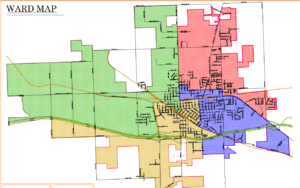
Sallisaw has the potential for growth and re-growth, stability and prosperity, and a meaningful quality of life for its residents. The key attributes we can strive for include:
- Economic growth
- Infrastructure and urban planning
- Community engagement
- Educational opportunities
- Innovation and entrepreneurship
- Quality of life
- Sustainable development
Selected Links to Sallisaw’s Web Pages
- Sallisaw’s City Government page
- Sallisaw’s Public Records process page
- City government document Archives
- City clerk document search Portal
- Customer Feedback Form
Other Explanations
Connect & Flow
Sallisaw’s Street, Transit, & Citizen Mobility Plan (Ideas)
Presently, our city is awkwardly connected. I envision improving traffic’s ease of movement throughout the city. The ideas use existing infrastructure in an improved way. Stage one is “Connect.” Stage two is “Flow.” These ideas would improve traffic travel time, convenience, and safety, improving the city’s attractiveness to businesses, visitors, and residents (Figure 2).
- Three pinch points occur at the I-40 west exit, the intersection of Cherokee and Maple, and at and near the railroad bridge in the lower right of this illustration.
- The absence of sidewalks, curbs, and crossings are remnants of an older city design.
- Large truck traffic loads exacerbate flow.
- Railroad tracks physically separate sections of the city, emphasizing artificial social boundaries.
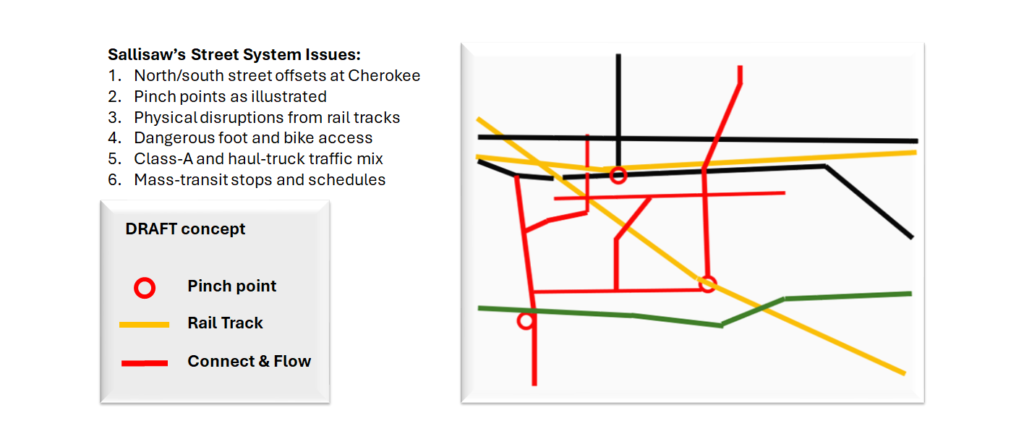
Efficiency & Prudence
I imagine Sallisaw’s city government providing equal or better services with efficiency and prudence. All organizations (private and public) have opportunities to streamline processes and share common resources among departments.
Most organizations have opportunities to decrease overall costs through several concurrent strategies. Sallisaw is similar in this regard. By considering leading practices from private and commercial enterprises and government entities, Sallisaw can benefit from a refreshed way of “doing things.”
In commercial settings with clients, I typically recommend addressing easy-to-implement, high impact cost reduction opportunities:
Browse examples: 1, 3, 5, 8, 9, 20, 21, 22, 23, 24, 25, 26, 29, 31, 34, 35, 36, and 38).
Savings can be used (invested) in higher-cost opportunities without borrowing or funding the initiatives from new sources.
While I have yet to learn the various cost savings opportunities, they are frequently found through a problem-solving approach known as ‘lean six sigma‘. This method focuses on finding ways to decrease the time it takes to perform work, reduce or eliminate waste, or improve consistency and accuracy for less rework.
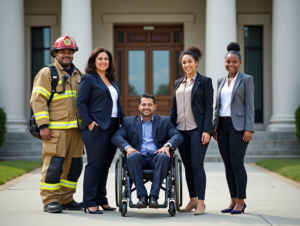
Ways to Save Cost (Specific Examples)
- #1 Ask the workers for their ideas
- Document processes to identify improvement areas
- Skill-up existing staff or hire the right staff for productivity
- Redesign administrative work to decrease time to complete
- Co-locate selected resources for better hand-offs
- Reduce or eliminate waste in material usage
- Improve consistency of task through standard procedures
- Redesign workflow to reduce errors
Jobs & Streets
I imagine Sallisaw with clear signs of economic development and industry diversification, increasing job opportunities, and new businesses in several industry sectors. I envision ongoing efforts to improve infrastructure, such as streets, utilities, public spaces, and public recreation attractions.

With discussions and planning, the Kibois Area Transit System (KAT) can make standard route runs similar to Stigler. Possibly, this, in addition to Uber-like services, could better connect housing areas to key stops.
Examples include connecting dense housing areas to employment. Anther idea would be regular routes with small weather projected transit stops to the library, activities, parks, medical needs, and dining and other similar destinations.
With commercial clients, I have helped to (i) reduce costs with “quick hits” and (ii) fund larger efforts with the savings. Ideas for cost savings could yield powerful results, especially with the help of city staff.
While I do not know, it is reasonable to set a goal of decreasing spending by 2–5%. These savings (about two million dollars) could be used as a ” carryover” to the next fiscal year to match various grants–especially infrastructure grants—without the need to raise more revenue.
Engaged City & Community
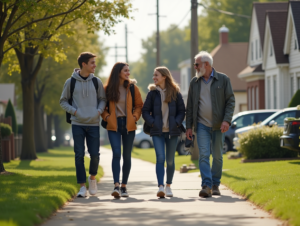
Imagine a strong sense of citizen engagement for those wanting engagement but also providing for others, such as visitors and traveling professionals. Together, we can encourage active participation from residents of all age groups.
We can enlist local organizations and draw from government agencies to host civic activities such as city-wide and smaller community events.
We can leverage our traditions into a renewed, elevated sense of unity and pride. Sallisaw already has a variety of traditions ranging from school sports, rodeos, parades, and holiday traditions. These are a strength we can build from.
Education & Skills

Our city can emphasize convenient access to quality education, including robust K-12 schools and higher education institutions (CASC and ICTC) supporting the commitment to nurturing a skilled and knowledgeable workforce.
Our city’s career and college systems already provide a wealth of skills development and business-aligned courses. However, ICTC and CASC offer services and learning experiences that the city can partner with in new ways. For example, ICTC has a partnership with OK APEX Accelerators. Especially with the VA facility, emerging small businesses may be able to leverage this into various government contracts.
Both campuses have facilities that could be used for various community events. Presently, these are under-utilized (in my opinion).
Getting There
To achieve a brighter future for this City, we must acknowledge that change almost always involves winners and losers. Even when everyone wins, some people win more than others. I call this Provocative Change because it can trigger various emotions, such as resistance, satisfaction, outrage, excitement, optimism, hope, and defiance.
Even if everyone in the City of Sallisaw could agree on a vision for the future, getting to that vision would be too slow for some and fast for others. The question of “how” to get something done becomes a question. Almost always, there is more than one way to solve a problem or achieve a goal.
Change management demands a high level of communication, discussion, constructive conflict resolution, decisive action, and, most importantly, the ability to learn from our missteps.
So, how can we get “there” wherever “there” might be?
- Start with the basics.
- Ensure the right people are in place.
- Use transparent and objective decision-making.
- Communicate effectively.
- Act with common sense and purpose.
- Implement exceptional project management.

- Listen to the people who are directly involved in the work.
- Foster teaching, mentoring, learning, and innovation.
- Embrace best practices from both business and government.
- Practice tolerance and celebrate successful outcomes.
What are Population Profiles?
Tapestry Types from ESRI (2022) are commonly used by large businesses to understand the market and other geographical dynamics. ESRI’s approach identifies broad similarities between groups by evaluating lifestyle, living conditions, education, geography, interests, and buying patterns. There are many other similar factors to consider.
Understanding a city’s opportunities and risks is useful for wisely managing growth and change. Making an honest assessment is important – the positive and negative. However, we also risk allowing our biases to influence and skew perspectives. It’s crucial to be cautious and attentive to these potential risks. I appreciate this CODEX of Biases when making such an assessment.
Who We Are
According to ESRI, we are “Hometown living” with “Small town sincerity.”
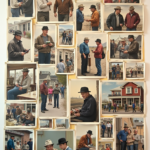
We generally have traditional values with a dash of Senior-living lifestyles.
Gen X-urban has influenced Sallisaw dynamics in recent years. The surrounding rural areas would be described as Cozy country living, Salt of the Earth, and Green acres.
ESRI’s descriptions of Rural bypasses, Rustic outposts, and Prairie living describe some of the surrounding areas. To fully describe the City of Sallisaw, a description of the surrounding area is also necessary.
Demographic Description
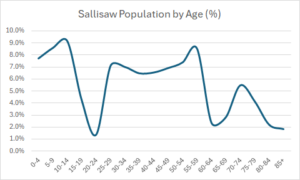
Sallisaw’s residents, experience diverse neighborhoods, challenges, pockets of community spirit, and genuine opportunity not presently fully realized. It is a tight-knit community with long-established, familiar family names serving as an advantage for some, pre-judgment toward others, and often with caution toward unfamiliar surnames.
Sallisaw grapples with poverty, limited employment, housing issues, and other social problems. However, it also has pockets of affluence characterized by large homes, manicured lawns, and new cars on the drive.
Most of Sallisaw is described as lower-middle—and middle-class families, single people, and single parents with children at home.
The significant drop in the number of young adults, as depicted in Figure 3, is likely a result of a combination of factors such as the group pursuing further education elsewhere and a scarcity of well-paying entry-level jobs.
A similar decline is observed in the late middle-aged demographic in Sallisaw. Still, the population starts to increase again in the elderly years.
Possibly, empty-nesters are preparing for retirement elsewhere. The uplift in population count for the elderly is possibly attributable to the elder-care facilities available.
My Description
The description here of Sallisaw and the surrounding area is my opinion. Still, my opinion draws from previous experience, such as using ESRI-type data. A more formal assessment might find different results, and you might have a differing opinion. I am expressing mine as a starting point for discussion.
Describing a population’s profile is different from promoting an area’s assets and opportunities. I believe that Sallisaw, with its unique and compelling assets, is a place of great opportunity.
Who are we? What do we represent? What can we become?
The city is loosely arranged into four political wards, each with an elected Commissioner. While not entirely accurate, Maple/Cedar Streets separates the city’s East and West portions. Cherokee separates North from South. Counterclockwise:
- Ward 1 is north of Cherokee and east of Maple (apx).
- Ward 2 is north of Cherokee and west of Maple (apx).
- Ward 3 is south of Cherokee and east of Maple (apx).
- Ward 4 is south of Cherokee and east of Maple (apx).
Ward 1 includes Highway 59, which connects to Stilwell, and mixed-use and semi-rural housing. The under-construction water park is at the southern edge of Redwood Street near the Sequoyah Hospital. Newer homes and neatly kept neighborhood streets are on the west portions of the ward.
Ward 2 includes newer subdivisions, portions of the old town with Highway 64 connecting to Vian and what had been Blue Ribbon Downs.
Ward 3 wraps around the municipal airport and cemetery with southward business growth, beginning with the VA and a new fuel/convenience store.
Ward 4 includes most of historic downtown and Highway 64, which connects to Muldrow, as well as a large sports complex and the lower grade schools.
As of September 24, 2024, the city board is:
- Mayor, Mr. Ernie Martens
- Ward 1, Mr. Kenny Moody
- Ward 2, Mr. Josh Bailey
- Ward 3, Mr. Julian Mendiola
- Ward 4, Mr. Brad Hamilton
Characteristics
A Small City with Traditional Values
Sallisaw includes young families and senior householders and reflects a down-to-earth, semirural lifestyle focusing on activities such as online computer games, renting movies, indoor gardening, hunting, and fishing. Many residents keep their finances simple, paying bills in person and avoiding debt, which reflects the community’s practical and straightforward approach to financial management.
The city is divided into four Wards. Download the Ward Map, and Zoning Map. Each ward is represented by an elected Commissioner, and the city as a whole is represented by an elected mayor. The city manager prepares a city budget each year and presents it for approval to the City of Sallisaw Board of Commissioners and others.
Most of Sallisaw’s residents prefer a price-conscious approach, using coupons at discount centers and relying on television or newspapers to stay informed. Others are more likely to carry credit card balances and use convenience stores for fuel and incidentals.
Sallisaw is a semirural lifestyle with domestic trucks, SUVs, ATVs, and vegetable gardens. Residents enjoy outdoor activities like hunting and fishing and watching sporting events like college football and basketball on TV or streaming media.
A large senior population visits doctors and health practitioners regularly. Many households favor convenience over cooking—such as frozen meals and fast food. Home improvement is not a priority, but vehicle maintenance is.
- Emphasis on community ties and a community-oriented lifestyle
- Preference for convenience in daily life
- Enjoyment of outdoor activities such as hunting and fishing
- Reliance on television for entertainment and staying informed
- Use of discount stores for shopping favoring budget-conscious shopping
A Small City with an Underbelly
Sallisaw is similar to other towns and small cities. Still, a realistic acknowledgment of Sallisaw’s strengths and struggles is required.
Sallisaw – in the Top Ten
- Top 10 affordable places to live in Oklahoma. (#3)
- Top 10 for the most dangerous cities in Oklahoma. (#9)
Small cities, often with a deceptive ‘underbelly,’ can initially charm with their close-knit communities, local businesses, and peaceful atmosphere. However, beneath this facade, there may be a darker side involving illegal activities such as trafficking, graft, illicit substance peddling, governmental favoritism, and behind-closed-doors deal-making.
Quiet streets and friendly facades can conceal illicit operations and criminal networks. These nefarious operations are often perpetuated by a few individuals who exploit the vulnerabilities within the community–even perpetuated by people in the political ranks.
This aspect of a city starkly contrasts the idyllic image often associated with small towns, highlighting the complexity and hidden issues within seemingly serene environments.
Red flags for this include:
- High turnover of establishments
- Unexplained wealth disparities
- Disproportionate crime rates
- Increased secrecy and mistrust
- Lack of oversight and governance
- Suspicious activity in unlikely places
While these six aspects in isolation would not prove deviance, they can serve as signals. Vigilance in identifying these signals, such as a constant turnover of businesses or noticeable wealth disparities, is crucial. It can encourage proactive measures against potential deviance.
Recognizing the signs of a community’s ‘underbelly, ‘such as high rates of crimes or a pervasive atmosphere of secrecy, fear, or mistrust, is not just important; it’s crucial. This recognition can prompt action against hidden criminal activities.
Ignoring the possibilities of an underbelly would be imprudent and naive.
An Example of Local Concern

My interest in putting my name forward for the City Manager role was sparked by a Facebook group page (Sallisaw Transparency). While various concerns and issues have been raised on the page, the original impetus stemmed from the administrator’s presumed discovery of impropriety.

